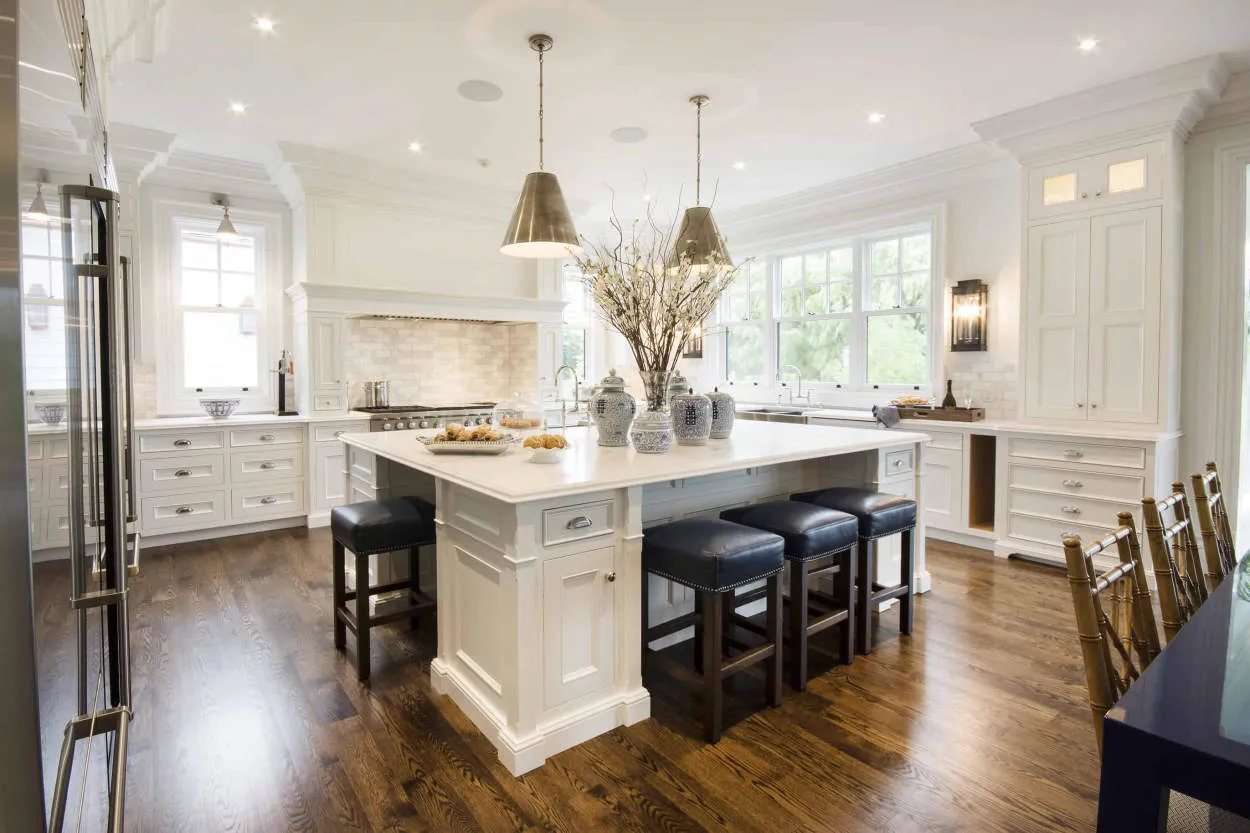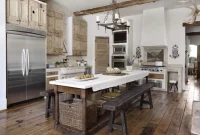Kitchen Islands are the epitome of practicality and style. Acting as a central hub, they provide additional storage, workspace, and a gathering spot for family and friends. With various designs and materials available, kitchen islands offer endless possibilities to enhance both the functionality and aesthetics of your kitchen space.
Island Design Concepts
In the world of kitchen design, islands have become a popular choice for homeowners looking to both elevate the function and style of their space. These versatile additions serve as a focal point, creating a central hub for cooking, dining, and entertaining. Let’s explore some island design concepts that can transform your kitchen into a more efficient and aesthetically pleasing area.
1. Multifunctional Islands
A key design trend is incorporating various functions within the island. Beyond serving as a food prep and cooking area, consider adding a sink, dishwasher, or wine refrigerator. This allows for easier access to essential kitchen tasks and keeps everything conveniently in one place.
2. Storage Solutions
Maximize the functionality of your island by incorporating smart storage solutions. Customizable drawers, shelves, and cabinets can be tailored to your specific needs. Utilize these storage options to keep your kitchen organized and free from clutter.
3. Style and Aesthetics
Your island should seamlessly blend into the overall design of your kitchen. Consider matching the materials and finishes to those used in your cabinetry and countertops for a cohesive look. Additionally, incorporating decorative elements such as pendant lighting or decorative panels can add a touch of elegance and personality.
4. Seating Arrangements
If space allows, adding seating to your island can create a casual dining area or a place for guests to gather while you prepare meals. Choose seating options that complement the style of your kitchen, whether it’s bar stools, built-in benches, or a combination of both.
5. Island Layout
The layout of your island is crucial for optimizing its functionality. Consider the work triangle between the stove, sink, and refrigerator to ensure an efficient workflow. Carefully plan the size and shape of your island to allow for easy movement around the kitchen.
6. Unique Features
For those looking to take their island design to the next level, consider incorporating unique features. This could include a built-in butcher block, a hidden prep sink, or even a slide-out cutting board. These thoughtful additions can elevate both the functionality and appeal of your island.
By focusing on the design concepts mentioned above, you can create a kitchen island that enhances both the practicality and style of your space. Whether you have a small kitchen or a large open-plan layout, incorporating an island can provide numerous benefits. Keep in mind your specific needs and preferences to design an island that becomes the heart of your kitchen.
Multi-Functional Islands
In the world of kitchen design, one feature that has gained significant popularity is the kitchen island. Kitchen islands serve as versatile and multi-functional spaces, enhancing both the functionality and style of any kitchen.
First and foremost, kitchen islands provide additional counter space, allowing for effortless meal preparation, cooking, and baking. The extra surface area also comes in handy when hosting gatherings or parties, providing a convenient space for guests to gather around and socialize.
Moreover, kitchen islands often come equipped with various storage options such as cabinets, drawers, and shelves. This additional storage space allows for better organization of kitchen essentials, such as pots, pans, utensils, and ingredients, making everything easily accessible and reducing clutter.
Besides their practicality, kitchen islands can also be a focal point of style in the kitchen. With a wide range of designs, materials, and finishes available, you can choose an island that perfectly complements the overall aesthetic of your kitchen. From sleek and modern to charming and rustic, there is an island style to suit every taste.
In addition, kitchen islands can serve as a central hub for various kitchen appliances. From built-in stovetops and sinks to wine coolers and dishwashers, islands can house an array of appliances that streamline your cooking process and improve efficiency.
To sum up, the use of kitchen islands has revolutionized kitchen design by adding both functionality and style. With their extra counter space, storage options, and potential for housing appliances, islands have become indispensable elements in modern kitchens. Embrace the versatility and elegance of multi-functional islands to transform your kitchen into a truly remarkable space.
Material Choices for Islands
When it comes to designing a kitchen island, one of the key decisions is choosing the right materials. The materials used for the island can greatly impact its functionality and style. Here are some popular material choices for kitchen islands:
1. Wood
Wood is a classic choice for kitchen islands. It adds warmth and a natural appeal to the space. Hardwoods like maple, oak, and cherry are popular options due to their durability. Wood can be stained or painted to match any kitchen style.
2. Granite
Granite is a highly durable and aesthetically pleasing material for kitchen islands. It is known for its heat and scratch resistance, making it perfect for food preparation. Granite also adds elegance and a touch of luxury to the kitchen.
3. Stainless Steel
For a sleek and modern look, stainless steel is a great choice. It is hygienic, easy to clean, and resistant to staining and corrosion. Stainless steel kitchen islands are commonly seen in professional or industrial-style kitchens.
4. Concrete
Concrete provides a unique and contemporary appeal to kitchen islands. It can be customized in terms of shape, color, and texture. Concrete islands are known for their durability and resistance to heat and scratches. They work well in minimalist and industrial-themed kitchens.
5. Quartz
Quartz is a popular choice for kitchen countertops, and it can also be used for islands. It is known for its durability, low maintenance, and wide range of colors and patterns. Quartz is resistant to stains and scratches, making it ideal for busy kitchens.
6. Marble
Marble adds a luxurious and sophisticated touch to kitchen islands. It is a natural stone that comes in various colors and veining patterns. While marble is beautiful, it requires regular sealing to protect it from stains and scratches.
When selecting the material for your kitchen island, consider both the practicality and aesthetics. Also, ensure that the material complements the overall design and style of your kitchen.
Integrating Seating Solutions
In the world of interior design, kitchen islands have gained immense popularity due to their ability to centralize both function and style in the heart of a home. While originally conceived as a strategic solution for expanding countertop space and storage, modern kitchen islands have evolved to incorporate seating options seamlessly.
Integrating seating solutions into kitchen islands not only maximizes the utility of the area but also creates a more inviting and social atmosphere. Whether it’s a cozy breakfast nook or a bar-style setup, the inclusion of seating adds a whole new dimension to the functionality of the kitchen island.
When considering the integration of seating solutions, it is crucial to take into account the available space and the overall design aesthetic of the kitchen. One popular option is to incorporate bar stools or counter height chairs, allowing for a quick meal or a place for guests to sit and chat while the host prepares food.
Another approach is the creation of a built-in banquette, which not only provides ample seating but also transforms the kitchen island into a cozy gathering spot. This arrangement works particularly well in open-concept kitchens, where the island becomes a natural focal point.
Furthermore, the choice of seating materials and finishes can greatly impact the overall style and ambiance of the kitchen. For a contemporary look, sleek and minimalistic seating options such as metal or acrylic chairs can be chosen. Alternatively, for a more rustic or traditional feel, wooden stools with comfortable cushions can be incorporated.
Ultimately, the integration of seating solutions into kitchen islands allows for a multifunctional space that combines culinary functionality and social interaction. It not only enhances the practicality of the kitchen but also adds an element of style that elevates the overall aesthetic of the home.
So, whether you’re looking to make the most of a small space or create a central hub for gatherings, integrating seating solutions into your kitchen island is an excellent choice that blends functionality, convenience, and style together in one captivating package.
Lighting Over Islands
In kitchen design, islands are a popular and functional addition. Not only do they provide extra workspace and storage, but they also serve as a focal point for the room. When it comes to lighting over islands, it’s essential to strike the right balance between function and style.
One popular lighting option for kitchen islands is pendant lights. These hanging fixtures not only provide ample illumination for food preparation and cooking but also add a touch of style to the space. Pendant lights come in a variety of designs, making it easy to find one that suits your kitchen’s aesthetic.
Another option for lighting over islands is recessed lighting. These lights are installed flush with the ceiling and provide a clean and sleek look. Recessed lighting offers even illumination and can be positioned strategically to highlight specific areas of your kitchen island.
In addition to pendant lights and recessed lighting, you may also consider installing a central chandelier or track lighting system. These options offer versatility in terms of both function and style. A chandelier can add an elegant and sophisticated touch to your kitchen, while track lighting allows you to adjust the direction and intensity of the light.
When choosing the right lighting over your kitchen island, it’s crucial to consider the size and layout of your space. For larger islands, multiple pendant lights or a combination of different lighting fixtures may be necessary to ensure adequate illumination. Additionally, the height at which you hang pendant lights is also important. Ideally, they should be positioned about 30 to 36 inches above the countertop.
In conclusion, lighting over islands plays a significant role in both the functionality and style of a kitchen. Whether you prefer pendant lights, recessed lighting, or a different option altogether, make sure to choose lighting fixtures that match your aesthetic while providing enough light for your everyday cooking needs.
Conclusion
In conclusion, kitchen islands are a valuable addition to any kitchen, as they provide both functional and stylish benefits. They offer extra storage space, a dedicated work area, and can serve as a gathering spot for family and friends. With their versatility and aesthetic appeal, kitchen islands have become a must-have feature in modern kitchens.




